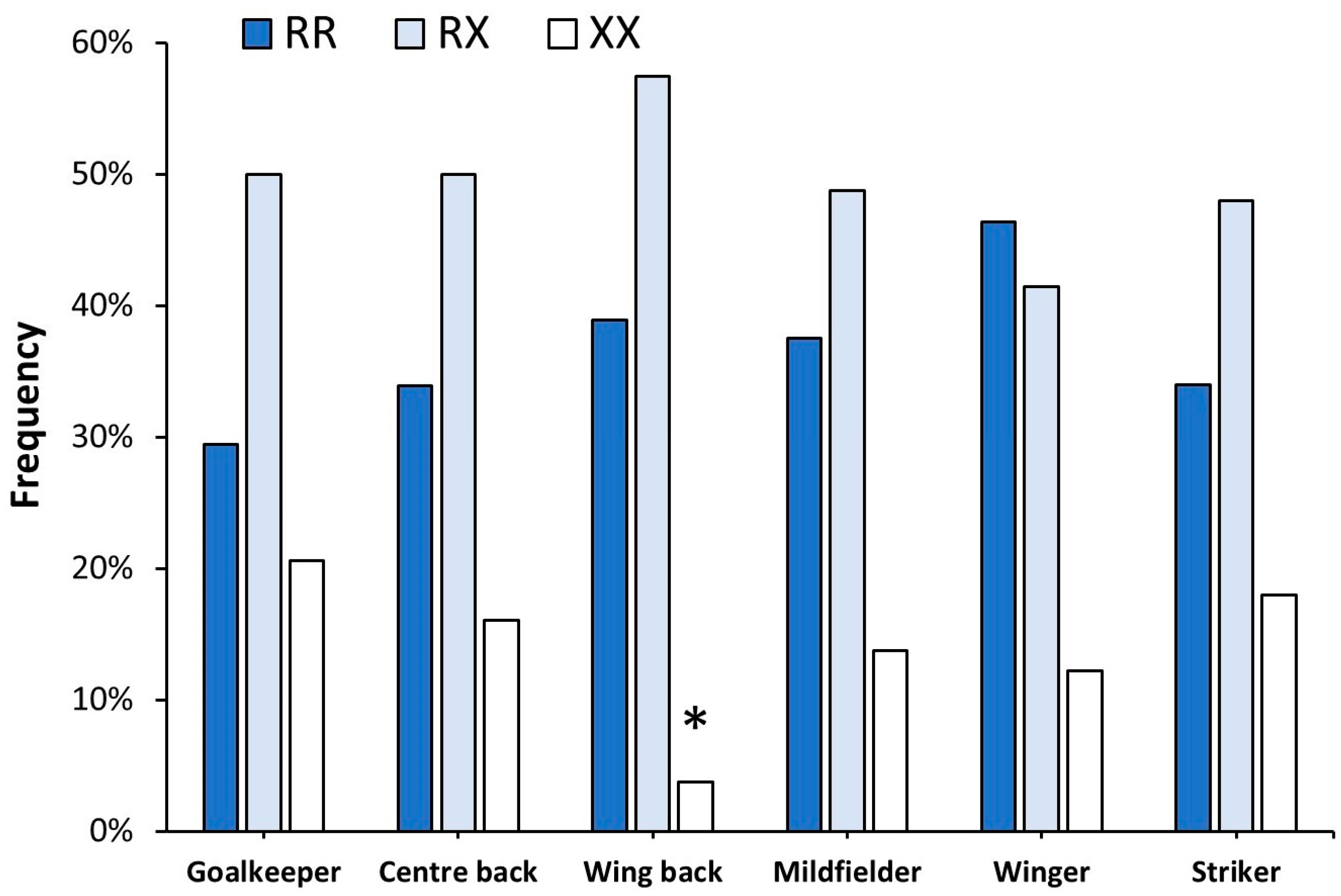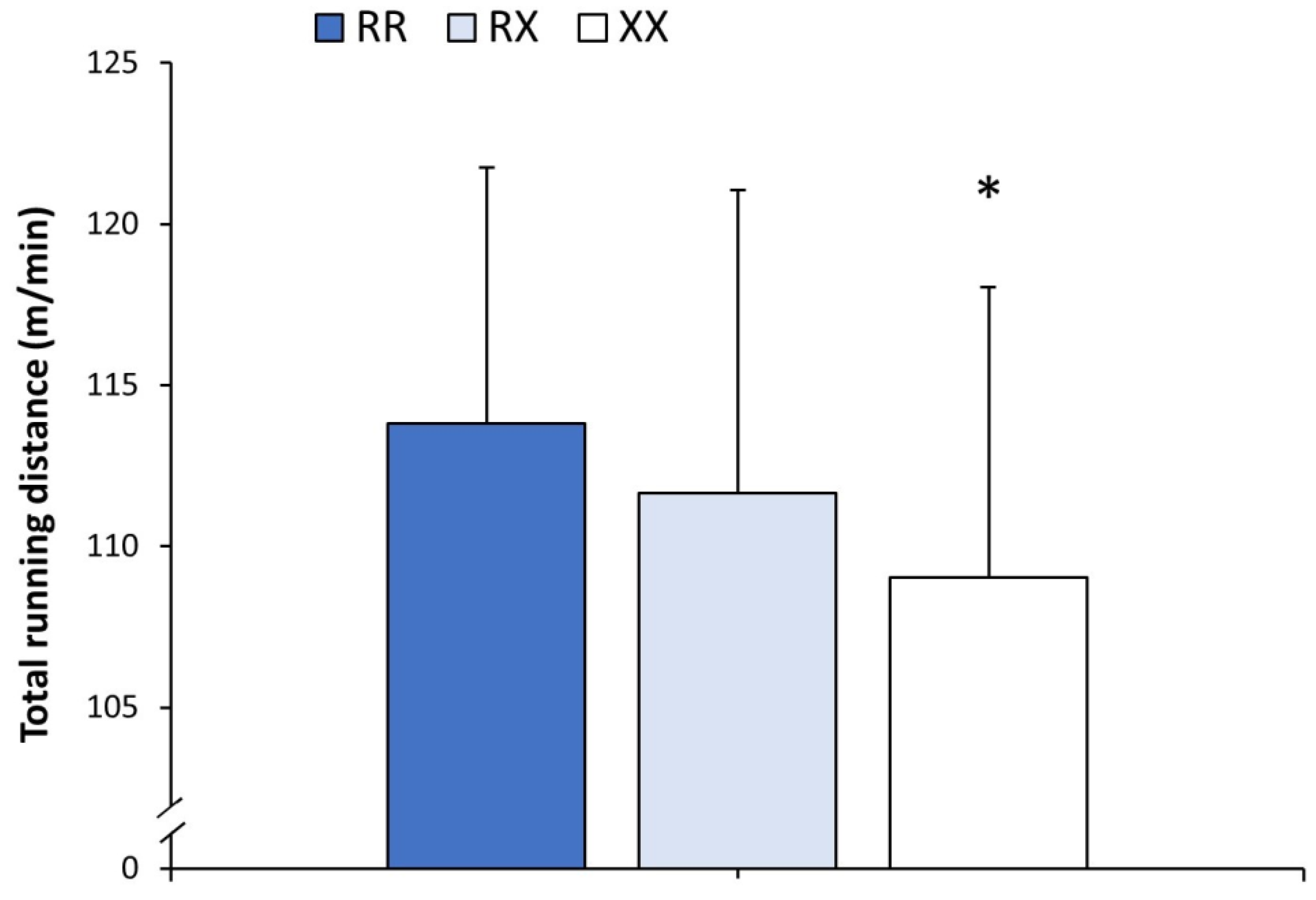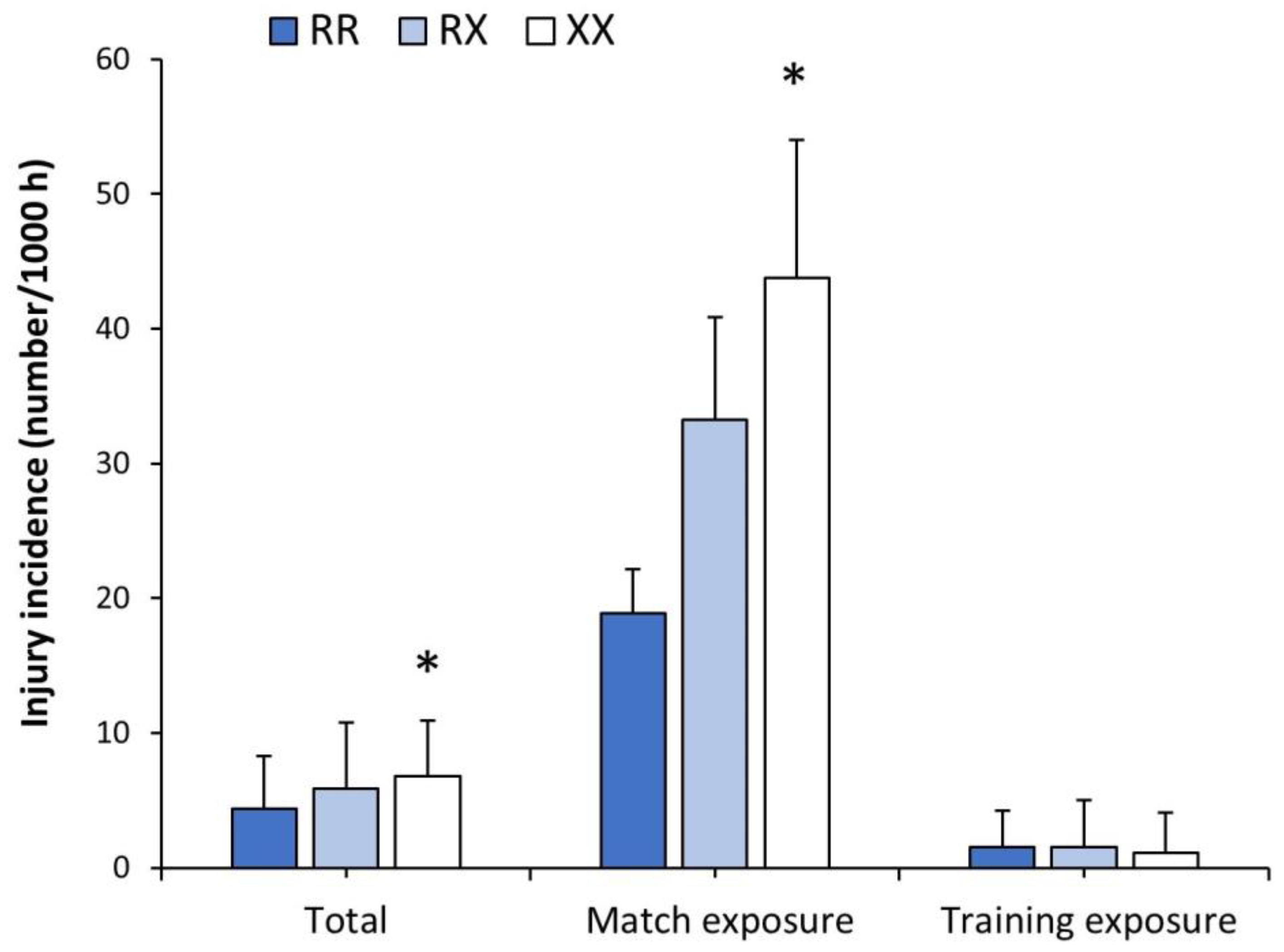ACTN3 XX Genotype Negatively Affects Running Performance and Increases Muscle Injury Incidence in LaLiga Football Players
Abstract
1. Introduction
2. Materials and Methods
2.1. Participants
2.2. Measures
2.2.1. Genetic Testing
2.2.2. Running Performance during Official Matches
2.2.3. Injury Data Collection
2.3. Statistical Analyses
3. Results
3.1. Sociodemographic Variables
3.2. Field Position
3.3. Running Performance during Official Matches
3.4. Team Performance
3.5. Injury Incidence
4. Discussion
4.1. ACTN3 and Running Performance
4.2. ACTN3 and Injury Incidence
4.3. Study Strengths
4.4. Study Limitations
5. Conclusions
Author Contributions
Funding
Institutional Review Board Statement
Informed Consent Statement
Data Availability Statement
Acknowledgments
Conflicts of Interest
References
- Houweling, P.J.; Papadimitriou, I.D.; Seto, J.T.; Pérez, L.M.; Del Coso, J.; North, K.N.; Lucia, A.; Eynon, N. Is evolutionary loss our gain? The role of ACTN3 p.Arg577Ter (R577X) genotype in athletic performance, ageing, and disease. Hum. Mutat. 2018, 39, 1774–1787. [Google Scholar] [CrossRef]
- North, K.N.; Beggs, A.H. Deficiency of a skeletal muscle isoform of alpha-actinin (alpha-actinin-3) in merosin-positive congenital muscular dystrophy. Neuromuscul. Disord. 1996, 6, 229–235. [Google Scholar] [CrossRef] [PubMed]
- Hogarth, M.W.; Garton, F.C.; Houweling, P.J.; Tukiainen, T.; Lek, M.; Macarthur, D.G.; Seto, J.T.; Quinlan, K.G.R.; Yang, N.; Head, S.I.; et al. Analysis of the ACTN3 heterozygous genotype suggests that α-actinin-3 controls sarcomeric composition and muscle function in a dose-dependent fashion. Hum. Mol. Genet. 2016, 25, 866–877. [Google Scholar] [CrossRef] [PubMed]
- Del Coso, J.; Hiam, D.; Houweling, P.; Pérez, L.M.; Eynon, N.; Lucía, A. More than a ‘speed gene’: ACTN3 R577X genotype, trainability, muscle damage, and the risk for injuries. Eur. J. Appl. Physiol. 2019, 119, 49–60. [Google Scholar] [CrossRef] [PubMed]
- Erskine, R.M.; Williams, A.G.; Jones, D.A.; Stewart, C.E.; Degens, H. The individual and combined influence of ACE and ACTN3 genotypes on muscle phenotypes before and after strength training. Scand. J. Med. Sci. Sport. 2014, 24, 642–648. [Google Scholar] [CrossRef] [PubMed]
- Zempo, H.; Tanabe, K.; Murakami, H.; Iemitsu, M.; Maeda, S.; Kuno, S. ACTN3 polymorphism affects thigh muscle area. Int. J. Sport. Med. 2010, 31, 138–142. [Google Scholar] [CrossRef]
- Seto, J.T.; Lek, M.; Quinlan, K.G.R.; Houweling, P.J.; Zheng, X.F.; Garton, F.; MacArthur, D.G.; Raftery, J.M.; Garvey, S.M.; Hauser, M.A.; et al. Deficiency of α-actinin-3 is associated with increased susceptibility to contraction-induced damage and skeletal muscle remodeling. Hum. Mol. Genet. 2011, 20, 2914–2927. [Google Scholar] [CrossRef]
- Yang, N.; Schindeler, A.; McDonald, M.M.; Seto, J.T.; Houweling, P.J.; Lek, M.; Hogarth, M.; Morse, A.R.; Raftery, J.M.; Balasuriya, D.; et al. α-Actinin-3 deficiency is associated with reduced bone mass in human and mouse. Bone 2011, 49, 790–798. [Google Scholar] [CrossRef]
- Baltazar-Martins, G.; Gutiérrez-Hellín, J.; Aguilar-Navarro, M.; Ruiz-Moreno, C.; Moreno-Pérez, V.; López-Samanes, Á.; Domínguez, R.; Del Coso, J. Effect of ACTN3 Genotype on Sports Performance, Exercise-Induced Muscle Damage, and Injury Epidemiology. Sports 2020, 8, 99. [Google Scholar] [CrossRef]
- Papadimitriou, I.D.; Lucia, A.; Pitsiladis, Y.P.; Pushkarev, V.P.; Dyatlov, D.A.; Orekhov, E.F.; Artioli, G.G.; Guilherme, J.P.L.F.; Lancha, A.H.; Ginevičiene, V.; et al. ACTN3 R577X and ACE I/D gene variants influence performance in elite sprinters: A multi-cohort study. BMC Genom. 2016, 17, 285. [Google Scholar] [CrossRef] [PubMed]
- Del Coso, J.; Salinero, J.J.; Lara, B.; Gallo-Salazar, C.; Areces, F.; Puente, C.; Herrero, D. ACTN3 X-allele carriers had greater levels of muscle damage during a half-ironman. Eur. J. Appl. Physiol. 2017, 117, 151–158. [Google Scholar] [CrossRef]
- Rodas, G.; Moreno-Pérez, V.; Del Coso, J.; Florit, D.; Osaba, L.; Lucia, A. Alpha-Actinin-3 Deficiency Might Affect Recovery from Non-Contact Muscle Injuries: Preliminary Findings in a Top-Level Soccer Team. Genes 2021, 12, 769. [Google Scholar] [CrossRef]
- Bloomfield, J.; Polman, R.; O’Donoghue, P. Physical Demands of Different Positions in FA Premier League Soccer. J. Sport. Sci. Med. 2007, 6, 63–70. [Google Scholar]
- McAuley, A.B.T.; Hughes, D.C.; Tsaprouni, L.G.; Varley, I.; Suraci, B.; Roos, T.R.; Herbert, A.J.; Kelly, A.L. The association of the ACTN3 R577X and ACE I/D polymorphisms with athlete status in football: A systematic review and meta-analysis. J. Sport. Sci. 2021, 39, 200–211. [Google Scholar] [CrossRef]
- Massidda, M.; Voisin, S.; Culigioni, C.; Piras, F.; Cugia, P.; Yan, X.; Eynon, N.; Calò, C.M. ACTN3 R577X Polymorphism Is Associated with the Incidence and Severity of Injuries in Professional Football Players. Clin. J. Sport Med. 2019, 29, 57–61. [Google Scholar] [CrossRef] [PubMed]
- Clos, E.; Pruna, R.; Lundblad, M.; Artells, R.; Esquirol Caussa, J. ACTN3 single nucleotide polymorphism is associated with non-contact musculoskeletal soft-tissue injury incidence in elite professional football players. Knee Surg. Sport. Traumatol. Arthrosc. 2019, 27, 4055–4061. [Google Scholar] [CrossRef]
- Vales-Vázquez, Á.; Casal-López, C.; Gómez-Rodríguez, P.; Blanco-Pita, H.; Serra-Olivares, J. Competitive profile differences between the best-ranked European football championships. Hum. Mov. 2017, 18, 97–105. [Google Scholar] [CrossRef]
- Tanisawa, K.; Wang, G.; Seto, J.; Verdouka, I.; Twycross-Lewis, R.; Karanikolou, A.; Tanaka, M.; Borjesson, M.; Di Luigi, L.; Dohi, M.; et al. Sport and exercise genomics: The FIMS 2019 consensus statement update. Br. J. Sport. Med. 2020, 54, 969–975. [Google Scholar] [CrossRef]
- Sambrook, J.; Fritsch, E.; Maniatis, T. Molecular Cloning: A Laboratory Manual, 2nd ed.; Cold Spring Harbor Laboratory Press: Cold Spring Harbor, NY, USA, 1989. [Google Scholar]
- De la Vega, F.M.; Lazaruk, K.D.; Rhodes, M.D.; Wenz, M.H. Assessment of two flexible and compatible SNP genotyping platforms: TaqMan SNP Genotyping Assays and the SNPlex Genotyping System. Mutat. Res. 2005, 573, 111–135. [Google Scholar] [CrossRef] [PubMed]
- Felipe, J.L.; Garcia-Unanue, J.; Viejo-Romero, D.; Navandar, A.; Sánchez-Sánchez, J. Validation of a video-based performance analysis system (Mediacoach) to analyze the physical demands during matches in LaLiga. Sensors 2019, 19, 4113. [Google Scholar] [CrossRef] [PubMed]
- Linke, D.; Link, D.; Lames, M. Football-specific validity of TRACAB’s optical video tracking systems. PLoS ONE 2020, 15, e0230179. [Google Scholar] [CrossRef]
- Bahr, R.; Clarsen, B.; Derman, W.; Dvorak, J.; Emery, C.A.; Finch, C.F.; Hägglund, M.; Junge, A.; Kemp, S.; Khan, K.M.; et al. International Olympic Committee consensus statement: Methods for recording and reporting of epidemiological data on injury and illness in sport 2020 (including STROBE Extension for Sport Injury and Illness Surveillance (STROBE-SIIS)). Br. J. Sport. Med. 2020, 54, 372–389. [Google Scholar] [CrossRef] [PubMed]
- 1000 Genome Database rs1815739. Available online: http://grch37.ensembl.org/Homo_sapiens/Variation/Sample?db=core;r=11:66327595-66328595;v=rs1815739;vdb=variation;vf=341845619#_ (accessed on 27 January 2023).
- Ade, J.; Fitzpatrick, J.; Bradley, P.S. High-intensity efforts in elite soccer matches and associated movement patterns, technical skills and tactical actions. Information for position-specific training drills. J. Sport. Sci. 2016, 34, 2205–2214. [Google Scholar] [CrossRef] [PubMed]
- Vigne, G.; Gaudino, C.; Rogowski, I.; Alloatti, G.; Hautier, C. Activity profile in elite Italian soccer team. Int. J. Sport. Med. 2010, 31, 304–310. [Google Scholar] [CrossRef]
- Del Coso, J.; de Souza, D.B.; Moreno-Perez, V.; Buldú, J.M.; Nevado, F.; Resta, R.; Del Campo, R.L. Influence of Players’ Maximum Running Speed on the Team’s Ranking Position at the End of the Spanish LaLiga. Int. J. Environ. Res. Public Health 2020, 17, 8815. [Google Scholar] [CrossRef]
- Krustrup, P.; Helge, E.W.; Hansen, P.R.; Aagaard, P.; Hagman, M.; Randers, M.B.; de Sousa, M.; Mohr, M. Effects of recreational football on women’s fitness and health: Adaptations and mechanisms. Eur. J. Appl. Physiol. 2018, 118, 11–32. [Google Scholar] [CrossRef]
- López-Valenciano, A.; Ruiz-Pérez, I.; Garcia-Gómez, A.; Vera-Garcia, F.J.; De Ste Croix, M.; Myer, G.D.; Ayala, F. Epidemiology of injuries in professional football: A systematic review and meta-analysis. Br. J. Sport. Med. 2019, 54, 711–718. [Google Scholar] [CrossRef]
- Cuthbert, M.; Ripley, N.; McMahon, J.J.; Evans, M.; Haff, G.G.; Comfort, P. The Effect of Nordic Hamstring Exercise Intervention Volume on Eccentric Strength and Muscle Architecture Adaptations: A Systematic Review and Meta-analyses. Sport. Med. 2020, 50, 83–99. [Google Scholar] [CrossRef]
- Bradley, P.S.; Portas, M.D. The relationship between preseason range of motion and muscle strain injury in elite soccer players. J. Strength Cond. Res. 2007, 21, 1155–1159. [Google Scholar]
- Ekstrand, J.; Hägglund, M.; Waldén, M. Injury incidence and injury patterns in professional football: The UEFA injury study. Br. J. Sport. Med. 2011, 45, 553–558. [Google Scholar] [CrossRef]
- Moreno-Pérez, V.; Soler, A.; Ansa, A.; López-Samanes, Á.; Madruga-Parera, M.; Beato, M.; Romero-Rodríguez, D. Acute and chronic effects of competition on ankle dorsiflexion ROM in professional football players. Eur. J. Sport Sci. 2020, 20, 51–60. [Google Scholar] [CrossRef] [PubMed]
- Pingault, J.; O’Reilly, P.; Schoeler, T.; GB, P.; Rijsdijk, F.; Dudbridge, F. Using genetic data to strengthen causal inference in observational research. Nat. Rev. Genet. 2018, 19, 566–580. [Google Scholar] [CrossRef] [PubMed]
- FIFA. Football Emergency Medicine Manual, 2nd ed.; Kramer, E., Dvorac, J., Eds.; FIFA Football for Health F-MARC: Zürich, Switzerland, 2022. [Google Scholar]
- Massidda, M.; Myamoto-Mikami, E.; Kumagai, H.; Ikeda, H.; Shimasaki, Y.; Yoshimura, M.; Cugia, P.; Piras, F.; Scorcu, M.; Kikuchi, N.; et al. Association between the ACE I/D polymorphism and muscle injuries in Italian and Japanese elite football players. J. Sport. Sci. 2020, 38, 2423–2429. [Google Scholar] [CrossRef]
- Massidda, M.; Bachis, V.; Corrias, L.; Piras, F.; Scorcu, M.; Calò, C.M. Influence of the COL5A1 rs12722 on musculoskeletal injuries in professional soccer players. J Sport. Med. Phys. Fit. 2015, 55, 1348–1353. [Google Scholar]
- Del Coso, J.; Rodas, G.; Buil, M.Á.; Sánchez-Sánchez, J.; López, P.; González-Ródenas, J.; Gasulla-Anglés, P.; López-Samanes, Á.; Hernández-Sánchez, S.; Iztueta, A.; et al. Association of the ACTN3 rs1815739 Polymorphism with Physical Performance and Injury Incidence in Professional Women Football Players. Genes 2022, 13, S2095–S2546. [Google Scholar] [CrossRef] [PubMed]




| Variable (Units) | RR | RX | XX | p Value |
|---|---|---|---|---|
| Sociodemographic variables | ||||
| Number (frequency, %) | 116 (36.8) | 156 (49.5) | 43 (13.7) | - |
| Age (years) | 26.8 ± 4.7 | 26.2 ± 4.7 | 26.8 ± 4.7 | 0.573 |
| Height (cm) | 181 ± 6 | 181 ± 6 | 182 ± 5 | 0.329 |
| Body mass (kg) | 76.0 ± 6.2 | 76.4 ± 7.3 | 77.7 ± 6.3 | 0.377 |
| Body mass index (kg/m2) | 23.3 ± 1.3 | 23.2 ± 1.4 | 23.3 ± 1.4 | 0.961 |
| Ethnicity | ||||
| Caucasian (%) | 97(33.7) | 149 (51.7) | 42 (14.6) | 0.002 |
| Afro-American (%) | 19 (73.1) ↑ | 6 (23.1) ↓ | 1 (3.8) | |
| Asian (%) | 0 (0.0) | 1 (0.6) | 0 (0.0) | |
| Match performance | ||||
| Total running distance (m/min) | 113.8 ± 7.9 | 111.7 ± 9.4 | 109.0 ± 9.0 * | 0.046 |
| Distance at 2.0–6.9 km/h (m/min) | 37.8 ± 2.8 | 37.6 ± 3.2 | 38.2 ± 2.6 | 0.711 |
| Distance at 7.0–13.9 km/h (m/min) | 42.1 ± 5.4 | 41.4 ± 6.1 | 39.9 ± 9.0 | 0.332 |
| Distance at 14.0–20.9 km/h (m/min) | 24.6 ± 4.8 | 23.3 ± 5.7 | 22.4 ± 6.3 | 0.139 |
| Distance at 21.0–23.9 km/h (m/min) | 4.0 ± 1.1 | 3.9 ± 1.2 | 3.5 ± 1.1 * | 0.042 |
| Distance at ≥24 km/h (m/min) | 3.1 ± 1.4 | 3.1 ± 1.3 | 2.7 ± 1.4 | 0.400 |
| Sprints (number/min) | 0.23 ± 0.08 | 0.23 ± 0.09 | 0.20 ± 0.08 * | 0.042 |
| Mean sprint distance (m) | 26.6 ± 1.2 | 26.4 ± 1.6 | 25.6 ± 1.2 | 0.653 |
| Mean sprint duration (s) | 5.1 ± 0.2 | 5.0 ± 0.3 | 4.9 ± 0.7 * | 0.049 |
| Peak running velocity (km/h) | 30.1 ± 1.6 | 30.2 ± 1.4 | 29.8 ± 2.1 | 0.619 |
| Match time (min) | 1587 ± 852 | 1561 ± 876 | 1489 ± 902 | 0.704 |
| Matches as starter (number) | 17 ± 10 | 19 ± 10 | 20 ± 10 | 0.489 |
| Matches as substitute (number) | 7 ± 5 | 7 ± 5 | 5 ± 5 | 0.202 |
| Training volume | ||||
| Total training time (min) | 13,175 ± 1296 | 13,095 ± 1115 | 13,332 ± 1213 | 0.667 |
| Variable (Units) | RR | RX | XX | p Value |
|---|---|---|---|---|
| Injury incidence | ||||
| Total injury incidence (injury per 1000 h) | 3.4 ± 3.9 | 4.9 ± 5.9 | 5.4 ± 4.2 * | 0.035 |
| Match injury incidence (injury per 1000 h) | 18.9 ± 3.3 | 33.3 ± 7.6 | 43.8 ± 10.2 * | 0.013 |
| Training injury incidence (injury per 1000 h) | 1.5 ± 2.7 | 1.6 ± 3.5 | 1.1 ± 3.0 | 0.718 |
| Injury type | ||||
| Muscle injury (injury per 1000 h) | 2.8 ± 3.8 | 4.2 ± 5.8 | 4.4 ± 4.2 * | 0.021 |
| Tendon injury (injury per 1000 h) | 0.2 ± 1.2 | 0.3 ± 2.2 | 0.5 ± 2.1 | 0.565 |
| Ligament injury (injury per 1000 h) | 0.8 ± 1.8 | 0.4 ± 1.4 | 0.8 ± 2.3 | 0.713 |
| Bone injury (injury per 1000 h) | 0.1 ± 0.6 | 0.1 ± 0.6 | 0.4 ± 2.0 * | 0.038 |
| Cartilage injury (injury per 1000 h) | 0.1 ± 0.8 | 0.1 ± 0.5 | 0.3 ± 1.9 | 0.517 |
| Nerve injury (injury per 1000 h) | 0.1 ± 6.9 | 0.1 ± 6.9 | 0.1 ± 5.9 | 0.997 |
| Other type of injury (injury per 1000 h) | 0.3 ± 1.3 | 0.4 ± 1.7 | 0.3 ± 1.9 | 0.808 |
| Return to play | ||||
| Muscle injury (days) | 16 ± 10 | 17 ± 12 | 20 ± 13 | 0.505 |
| Tendon injury (days) | 26 ± 32 | 26 ± 25 | 18 ± 23 | 0.549 |
| Ligament injury (days) | 54 ± 77 | 66 ± 67 | 54 ± 43 | 0.892 |
| Bone injury (days) | 11 ± 5 | 11 ± 5 | 29 ± 36 | 0.064 |
| Cartilage injury (days) | 18 ± 15 | 16 ± 19 | 13 ± 15 | 0.595 |
| Nerve injury (days) | 2 | 19 | 3 | 0.569 |
| Other type of injury (days) | 11 ± 3 | 11 ± 8 | 3 ± 3 | 0.565 |
Disclaimer/Publisher’s Note: The statements, opinions and data contained in all publications are solely those of the individual author(s) and contributor(s) and not of MDPI and/or the editor(s). MDPI and/or the editor(s) disclaim responsibility for any injury to people or property resulting from any ideas, methods, instructions or products referred to in the content. |
© 2024 by the authors. Licensee MDPI, Basel, Switzerland. This article is an open access article distributed under the terms and conditions of the Creative Commons Attribution (CC BY) license (https://creativecommons.org/licenses/by/4.0/).
Share and Cite
Del Coso, J.; Rodas, G.; Soler-Aguinaga, A.; López-Del Campo, R.; Resta, R.; González-Rodenas, J.; Ferrandis, J.; Moreno-Pérez, V. ACTN3 XX Genotype Negatively Affects Running Performance and Increases Muscle Injury Incidence in LaLiga Football Players. Genes 2024, 15, 386. https://doi.org/10.3390/genes15030386
Del Coso J, Rodas G, Soler-Aguinaga A, López-Del Campo R, Resta R, González-Rodenas J, Ferrandis J, Moreno-Pérez V. ACTN3 XX Genotype Negatively Affects Running Performance and Increases Muscle Injury Incidence in LaLiga Football Players. Genes. 2024; 15(3):386. https://doi.org/10.3390/genes15030386
Chicago/Turabian StyleDel Coso, Juan, Gil Rodas, Aitor Soler-Aguinaga, Roberto López-Del Campo, Ricardo Resta, Joaquín González-Rodenas, Jordi Ferrandis, and Víctor Moreno-Pérez. 2024. "ACTN3 XX Genotype Negatively Affects Running Performance and Increases Muscle Injury Incidence in LaLiga Football Players" Genes 15, no. 3: 386. https://doi.org/10.3390/genes15030386
APA StyleDel Coso, J., Rodas, G., Soler-Aguinaga, A., López-Del Campo, R., Resta, R., González-Rodenas, J., Ferrandis, J., & Moreno-Pérez, V. (2024). ACTN3 XX Genotype Negatively Affects Running Performance and Increases Muscle Injury Incidence in LaLiga Football Players. Genes, 15(3), 386. https://doi.org/10.3390/genes15030386








